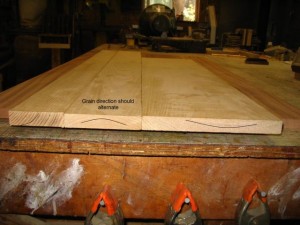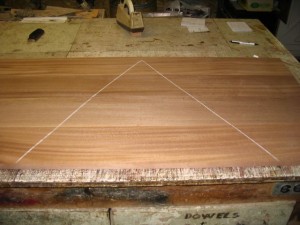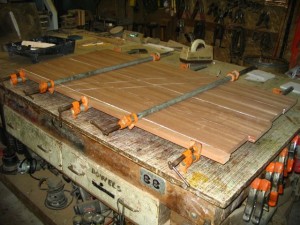Many times during furniture construction components wider than the available lumber are needed.
In order to lay up a top that will stay reasonably flat, some planning must be used. After properly dimensioning the stock, lay the boards out and decide the placement of each within the top.During this process be sure to have the annual rings alternate from board to board. When a board warps it will curl towards the outside of the tree, away from the center of the tree or in the opposite direction of the curvature of the annual rings.
It is better to have six, three-inch boards to make up an 18″ top than three, six-inch boards. The narrower the boards the flatter the top will stay. Mark the boards with chalk to keep them in proper order.
There are several ways to join the boards together. The easiest is to merely edge glue the flat edges together, but keeping the boards aligned while clamping is very difficult and generally requires the boards to be thicker than the finished top so the misalignment can be planed out.
A spline can be run the entire length, which will greatly assist with aligning the pieces and strengthen the joint.
A plate joiner is another option
Personally, I like to use a glue joint cutter.
This cutter in available as a shaper cutter or a router bit. The advantage of this cutter over a spline is that all the edges are cut with the same setup without having to machine and fit a separate spline. It also increases the surface area of the joint, which increases the strength.
After treating the edges with whichever joint you choose, it’s time to clamp things up. Alternate the clamps to balance the clamping pressure on both sides of the top otherwise you’ll build a warp into the top. Be sure to keep the clamps from touching the glue line either with wax paper or using a spacer between the clamp bar and top.





